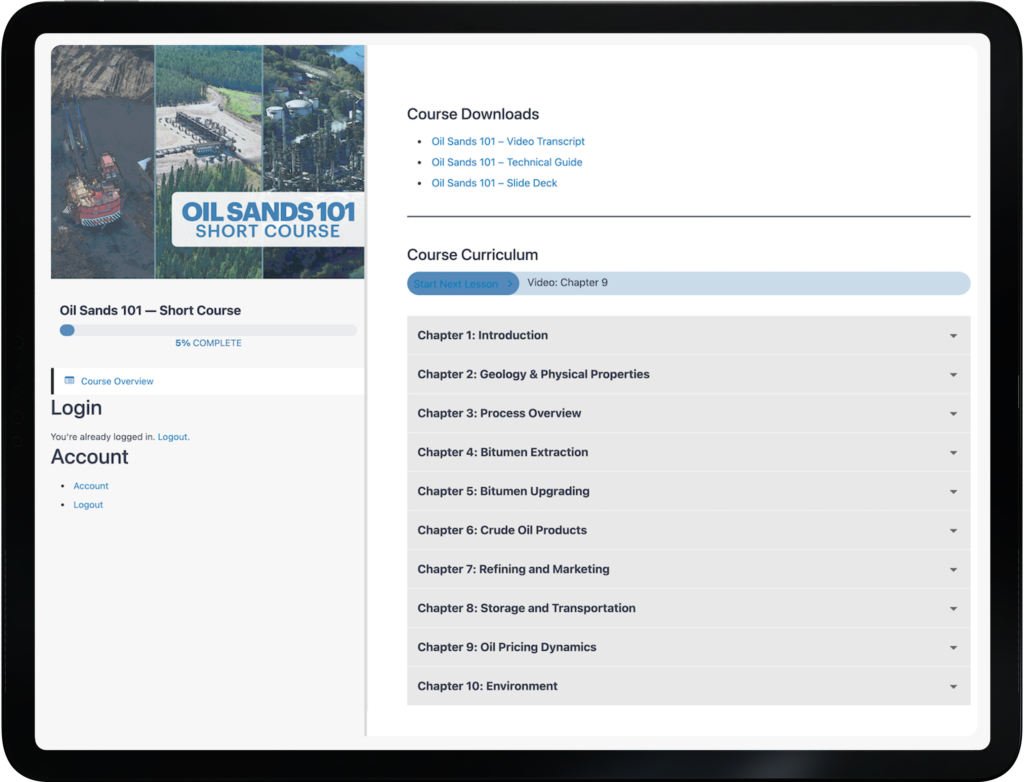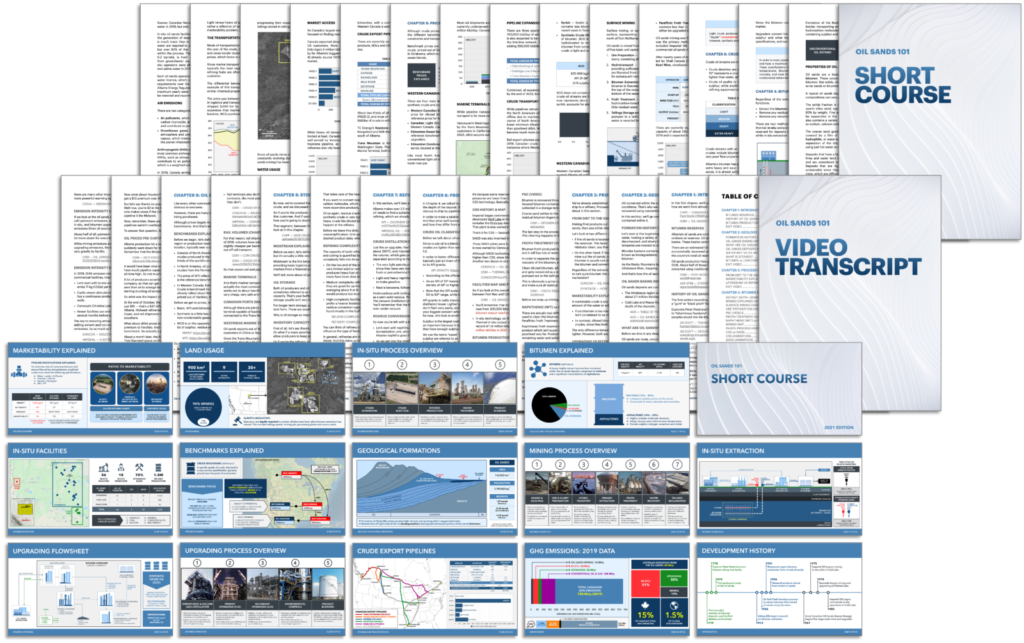ALREADY A MEMBER? Please log-in here →
HAVING TROUBLE LOGGING-IN? Please clear your cache and log-in again.
COURSE DESCRIPTION
From the ground, to your gas tank and beyond. See how the oil sands play a critical role in North American energy markets.
LENGTH: 10 VIDEO LESSONS (1 HRS 50 MIN)
RELEASE DATE: MAR 2022
UPDATED: FEB 2025

WHAT YOU’LL LEARN
THE RESOURCE IN THE GROUND
Starting from the very beginning — geological formations, the properties of bitumen and what makes it different than conventional crude.
FROM BITUMEN TO MARKETABLE CRUDE
How the resource is extracted from the ground, and converted into an intermediate crude product, either through upgrading or dilution.
REFINING AND MARKETING
The business of crude oil storage, transportation and refining, and the marketing challenges specific to crude produced from the oil sands.
PRICING DYNAMICS
Characteristics of crude benchmarks produced from the oil sands, how they are priced, and what drives the differentials between the different crude streams.
ENVIRONMENTAL FOOTPRINT
A summary of the environmental impacts, including land usage, water consumption and GHGs, and some of the work underway to reduce the industry’s footprint.
COURSE PREVIEW
WHAT’S INCLUDED

10 Video Lessons and Quizzes • 1 hr 50 min
Technical Guide (2025 Edition) • 32 page PDF
Slide Deck (2025 Edition) • 64 page PDF
Video Transcript (2025 Edition) • 36 page PDF
References & Further Reading (2025 Edition) • 15 page PDF
$150
COURSE CURRICULUM
CHAPTER 1: INTRODUCTION
• Bitumen deposits and reserves
• History of oil sands development
• Bitumen production profile
CHAPTER 2: GEOLOGY & PHYSICAL PROPERTIES
• History of geological formations
• Alberta’s oil sands basins
• Oil sands geology and physical properties
• Properties of bitumen and asphaltenes
• Bitumen vs light/med/heavy conventional oil
CHAPTER 3: PROCESS OVERVIEW
• From the deposit to final products
• Crude marketability explained
• Upgrading vs refining
CHAPTER 4: BITUMEN EXTRACTION
• Mining vs in-situ by deposit depth
• Surface mining — process overview
• Surface mining — NFT vs PFT process
• Surface mining — facilities list and map
• In-situ extraction — process overview
• In-situ extraction — CSS vs SAGD
• In-situ extraction — facilities list and map
• Oil sands facilities map and bitumen production
CHAPTER 5: BITUMEN UPGRADING
• Residue upgrading defined
• Crude distillation fractions
• Cracking and coking defined
• Bitumen upgrading — process overview
• Upgrader map and history
• Synthetic crude production profile
CHAPTER 6: PRODUCTS FROM THE OIL SANDS
• How crude oils are classified
• Popular benchmarks — API vs sulphur content
• Crude streams from the oil sands
• Oil sands production by type
CHAPTER 7: REFINING AND MARKETING
• Crude distillation fractions
• Residue conversion and product refining
• Refinery complexity explained
• Refining economics
• Distillation fractions by crude grade
• Diluted bitumen vs synthetic crude
• Refining map and crude trade flows
• Synthetic crude usage and exports
• Diluted bitumen usage and exports
CHAPTER 8: STORAGE AND TRANSPORTATION
• Midstream explained
• Crude oil storage — map and capacity
• Crude oil storage — blending and hedging
• Export pipelines — map and capacity
• Rail transport — map and capacity
• Marine export terminals
• Exports by method of transport
• Exports by destination
• Transportation costs comparisons
CHAPTER 9: OIL PRICING DYNAMICS
• Crude benchmarks explained
• Oil prices by location and grade
• Price differentials — unconstrained case
• Price differentials — constrained case
CHAPTER 10: ENVIRONMENT
• Regulatory oversight
• Land usage — in-situ vs mining
• Land usage — fine fluid tailings
• Land usage — fines dewatering
• Land usage — reclamation examples
• Water usage — in-situ vs mining
• Air emissions — pollutants vs GHGs
• Air emissions — GHG emission intensities
• Air emissions — GHG accounting methods
• Air emissions — Well-to-wheels comparisons
• Air emissions — path to net zero by 2050
FAQs
WHAT IS THE COURSE FORMAT?
Each lesson includes a short video and quiz. An in-depth technical guide is provided as background reading material. Additional charts, graphs and flowsheets are included in the slide deck. A full transcript of the video, including references, and links to further reading, is also provided.
HOW LONG DOES IT TAKE TO COMPLETE THE COURSE?
All 10 videos take about 2 hours to complete, but you can go at your own pace. Each time you login, you can continue where you left off. You can also go back and review the previous lessons, as needed.
HOW LONG DO I HAVE TO COMPLETE THE COURSE?
Course is open for 30-days after registration. If you need more time, please contact us.
WHAT KIND OF BACKGROUND OR EXPERIENCE DO I NEED?
This course is suitable for all levels, and doesn’t require any knowledge of oil processing.
CAN I RECEIVE A CERTIFICATE OF COMPLETION FOR THE COURSE?
Once all chapters are completed, a downloadable “Certificate of Completion” will appear on the left sidebar.
DO YOU OFFER CORPORATE DISCOUNTS?
Yes. Please contact us and let us know what you need (number of users and desired timeframe for completion).
WHAT IF I STILL HAVE MORE QUESTIONS?
No problem — just send us an email!